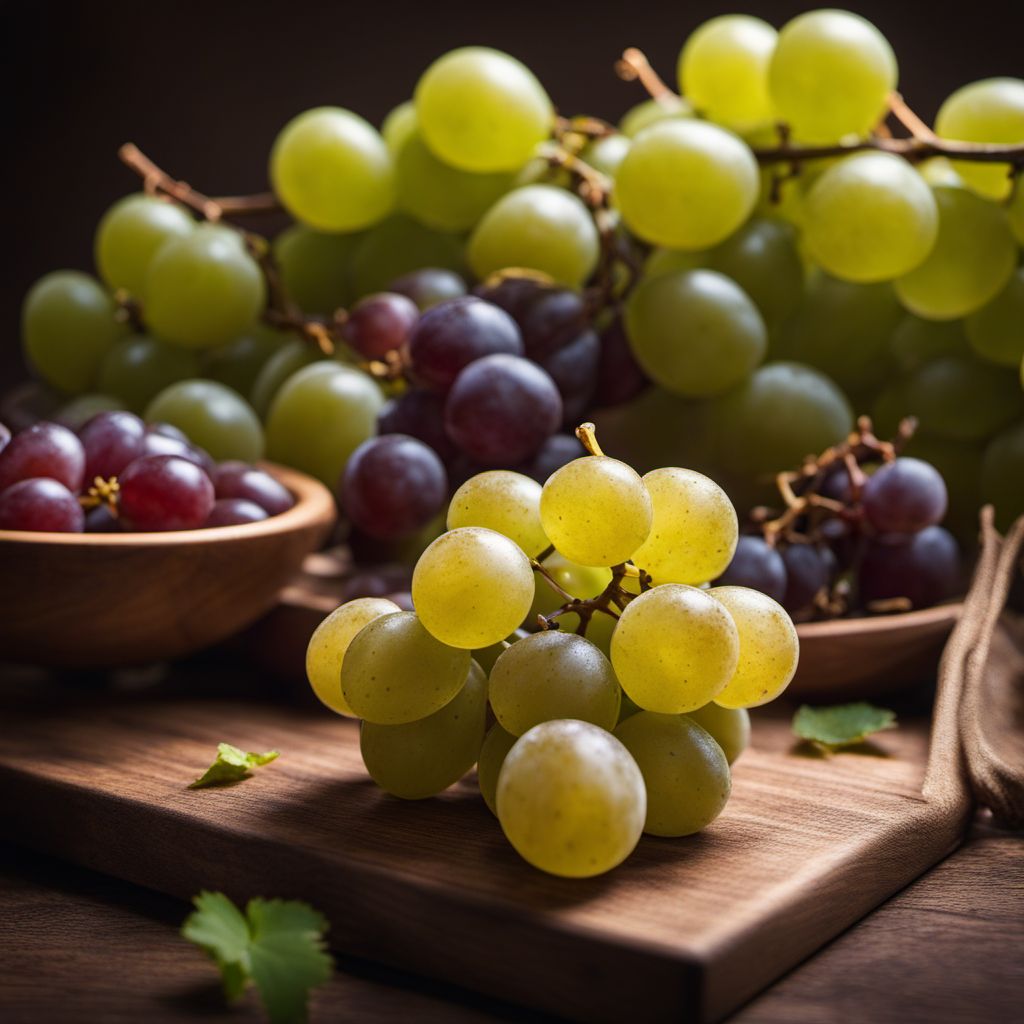
Ingredient
Table grapes and similar-
The Versatile Gems of Vineyards
Table grapes and similar varieties encompass a wide range of grapes that are specifically grown for eating fresh. They come in various colors, including green, red, and black, and can have different sizes and shapes. These grapes are known for their crisp texture, juicy sweetness, and refreshing flavors. They are enjoyed as a healthy snack and are widely used in salads, desserts, and beverages.
Origins and history
The cultivation of table grapes dates back thousands of years, with evidence of grape domestication found in ancient Egypt and Mesopotamia. Over time, different grape varieties were developed and spread across the world. Today, table grapes are grown in many countries with suitable climates, including the United States, Italy, Spain, and Australia. They are an integral part of many cultures and cuisines, symbolizing abundance, fertility, and celebration.
Nutritional information
Table grapes and similar varieties are a good source of vitamins, minerals, and antioxidants. They are particularly rich in vitamin C and contain dietary fiber. Grapes also contain natural sugars, so they should be consumed in moderation as part of a balanced diet. The nutritional content may vary slightly depending on the specific variety.
How to select
When selecting table grapes, look for plump, firm grapes that are firmly attached to the stem. The skin should be smooth and free from wrinkles or blemishes. Grapes that are slightly soft or have a powdery coating may indicate overripeness. Choose grapes that are well-colored for their variety, as this is an indicator of ripeness. Avoid grapes with moldy or damaged berries.
Storage recommendations
To maintain the freshness of table grapes, store them unwashed in the refrigerator in a perforated plastic bag or a breathable container. This helps to retain their moisture while allowing any excess moisture to escape. Properly stored, table grapes can last for up to a week. Before consuming, rinse the grapes under cold water and pat them dry.
How to produce
Table grapes can be grown in home gardens or vineyards, provided the right climate and growing conditions. They require full sun, well-drained soil, and proper trellising for support. Different grape varieties have specific requirements, so it's important to choose varieties that are suitable for your region. Pruning and regular care are necessary for optimal growth and fruit production.
Preparation tips
Table grapes and similar varieties are incredibly versatile and can be used in a variety of culinary creations. They are a popular addition to fruit salads, cheese platters, and charcuterie boards. Grapes can be used in desserts like tarts, pies, and sorbets, or incorporated into baked goods like bread and cakes. They also pair well with savory dishes, such as salads, roasted meats, and grain-based dishes. Additionally, grapes can be juiced or blended into smoothies and cocktails.
Culinary uses
Table grapes and similar varieties are widely used in many cuisines around the world. They are a staple in Mediterranean and Middle Eastern cuisines, where they are incorporated into both sweet and savory dishes. Grapes are also a key ingredient in winemaking, with different grape varieties used to produce various types of wines. Table grapes are commonly available in regions where they are cultivated, such as the United States, Italy, Spain, and Australia.
Availability
Table grapes and similar varieties are commonly available in grocery stores, supermarkets, and farmers markets. They are widely cultivated in many countries, including the United States, Italy, Spain, and Australia. The availability may vary depending on the season and location.
More ingredients from this category
Recipes using Table grapes and similar-

Romanian-style Steamed Buns
Savory Romanian Delights: Steamed Buns with a Twist

Bun Kebab with Spicy Potato Patties
Savor the Flavors of Pakistan: Spicy Potato Patties in a Bun

Classic Almond Bakewell Pudding
Heavenly Almond Delight: Classic Bakewell Pudding Recipe

Wisconsin-style Cheese Curd Vada Pav
Cheesy Curd Delight: Wisconsin-style Vada Pav

Stack Cake Recipe
Spiced Apple Stack Cake: A Tower of Delight

Congolese Fraisier
Tropical Delight: Congolese Fraisier with a Twist

Pie Barm Recipe
Savory Delight: Ultimate Pie Barm

Steamed Pork Buns
Fluffy Pillows of Savory Delight: Steamed Pork Buns

